

An encyclopedia of Middle-earth and Numenor

|
|
|
|
|
|
|
|
|
|
|
|
|
|
| |
|
 |

An encyclopedia of Middle-earth and Numenor |
 |

Names &
Etymology:
In Old English, the word ald
means "old"; a burg is a fortress or walled town.
Source:
Unfinished
Tales: "The Battles of the Fords of Isen - Appendix," p. 367, second
note
Bag End |
Inside
Bag End by John Howe
|
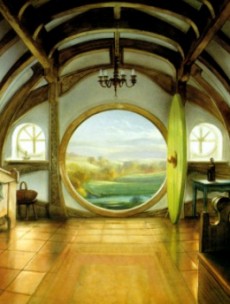 Home
of Bilbo Baggins in Hobbiton
in the Westfarthing of the Shire. Bag End was
a spacious Hobbit-hole built in the side of the
Hill near the Water. Three smaller
holes were located on the at the bottom of the Hill on Bagshot
Row.
Home
of Bilbo Baggins in Hobbiton
in the Westfarthing of the Shire. Bag End was
a spacious Hobbit-hole built in the side of the
Hill near the Water. Three smaller
holes were located on the at the bottom of the Hill on Bagshot
Row.
Bag End had a round, green door with a brass knob in the middle. The interior doors were also round, as were the windows. The main hallway was rounded like a tunnel, with rooms on either side - the best being on the left-hand side because they had windows overlooking the garden and beyond. The rooms were all on the same level. They included bedrooms, bathrooms, cellars, pantries, wardrobes, kitchens, dining rooms, and a study. The rooms were comfortably furnished, the walls were panelled, and the floors were tiled and carpeted.
Bag End was built by Bilbo's father Bungo Baggins on the occasion of his marriage to Belladonna Took. After his mother's death in 2934 of the Third Age, Bilbo inherited Bag End and lived there peacefully for some time until Gandalf the Grey came along one day in 2941 and persuaded Bilbo to go on an adventure. When Bilbo returned he discovered that he was presumed dead and that the Sackville-Bagginses were measuring the rooms of Bag End in anticipation of moving in. They were sorely disappointed.
Bilbo lived alone at Bag End until he invited his orphaned cousin Frodo Baggins to live with him around 2989. Bilbo left Bag End to Frodo when he left the Shire in 3001. When Frodo in turn left the Shire with the One Ring, he sold Bag End at a bargain price to Lobelia Sackville-Baggins, on the pretense that his money was running out and he was moving to a smaller residence at Crickhollow in Buckland. Frodo left Bag End on September 23, 3018.
After the War of the Ring, Saruman traveled to the Shire, where he had contacts with Lotho Sackville-Baggins and others. There he hoped to seek revenge for the destruction of Isengard by spreading destruction to the Hobbits' homeland. Saruman moved into Bag End and ousted the Sackville-Bagginses by having Lobelia arrested and Lotho killed. Frodo returned and ordered Saruman to leave, but as he left Saruman was killed by Grima.
When Lobelia was released from the Lockholes, she gave Bag End back to Frodo. Bag End was restored to its former comfortable state. Frodo invited Sam Gamgee and Sam's new wife Rosie to move in with him in May of 3020. When Frodo left Middle-earth in 3021, he gave Bag End and its contents to Sam and his descendants.
Names &
Etymology:
The name Bag End was meant
to imply "cul-de-sac." It was the local name of Tolkien's aunt's farm in
Worcestershire, which was located at the end of a lane that led no further.
Sources:
The Hobbit:
"An Unexpected Party," p. 9-11; "The Last Stage," 313-14
The Fellowship
of the Ring: "Three Is Company," p. 75-6
The Return
of the King: "The Scouring of the Shire," p. 298-300; "The Grey Havens,"
p. 301, 304, 309
The Atlas
of Middle-earth by Karen Wynn Fonstad, p. 118-19
"Nomenclature
of The Lord of the Rings," entry for Bag End
Bagshot Row |
Bagshot
Row by J.R.R. Tolkien
|
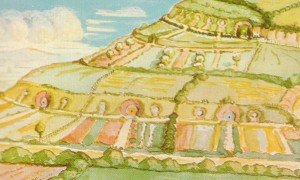 Lane
at the bottom of the Hill below Bag
End. There were three smaller Hobbit-holes along Bagshot Row numbered
1, 2, and 3.
Sam Gamgee and his father Hamfast
lived at Number 3 Bagshot Row. Daddy
Twofoot was the Gaffer's next-door neighbor at Number 2 Bagshot Row.
Lane
at the bottom of the Hill below Bag
End. There were three smaller Hobbit-holes along Bagshot Row numbered
1, 2, and 3.
Sam Gamgee and his father Hamfast
lived at Number 3 Bagshot Row. Daddy
Twofoot was the Gaffer's next-door neighbor at Number 2 Bagshot Row.
During the War of the Ring, when Saruman's minions occupied the Shire, Bagshot Row was dug up and replaced with a sand and gravel quarry. Sam's father and the other tenants were forced out of their homes and placed in shacks. After the Hobbits expelled the invaders, one of the first things they did was restore Bagshot Row. New holes were dug in the south side of the Hill. The holes were lined with brick, and a sheltered garden was planted in front. Hamfast Gamgee moved back into Number 3.
New names were considered for the restored Bagshot Row, including Better Smials and Battle Gardens, but in the end New Row was chosen. In Bywater, it was jokingly referred to as Sharkey's End because Saruman had met his death on the Hill.
Names &
Etymology:
Bagshot Row was so named
because the holes were dug into a slope that was formed when the excess
dirt from the digging of Bag End was "shot" over a steep side of the Hill.
Sources:
The Fellowship
of the Ring: "A Long-Expected Party," p. 30, 34
The Return
of the King: "The Scouring of the Shire," p. 291, 296; "The Grey Havens,"
p. 302
"Nomenclature
of The Lord of the Rings," entry for Bagshot Row
The farm buildings were surrounded by a high wall with a wooden gate. The large house and farm buildings were made of brick and had thatched roofs. Farmer Maggot and Mrs. Maggot lived there with their children, including two sons and three daughters. Farmer Maggot also employed other Hobbits who worked on his farm.
As a child, Frodo Baggins had gone to Bamfurlong to steal mushrooms and had been caught by Farmer Maggot, who threatened to set his dogs on the young Hobbit if he returned. Frodo inadvertently returned to Bamfurlong on September 25, 3018 of the Third Age, with Sam Gamgee and Pippin Took. The Hobbits had become disoriented while trying to avoid a Black Rider in the Woody End and emerged from the wood farther south than they had intended. Pippin recognized the land as Bamfurlong.
They approached the farm house, and when Farmer Maggot realized who they were he invited them in for supper and told them that a Black Rider had come to the farm seeking news of someone named Baggins. After supper, he drove the Hobbits to the Bucklebury Ferry in his cart.
Names &
Etymology:
The name Bamfurlong did not
have a clear meaning in the Shire, but it probably
meant "bean field." The element bam is likely derived from "bean."
A furlong is a division of a common field.
Sources:
The Fellowship
of the Ring: "A Short Cut to Mushroom," p. 100-107
"Nomenclature
of The Lord of the Rings," entry for Bamfurlong
Brandy Hall was built by Gorhendad Oldbuck, who crossed the river and settled in Buckland in 2340 of the Third Age. He then changed the family name to Brandybuck and began the excavation of Brandy Hall. The head of the Brandybuck family, called the Master of Buckland, traditionally made his home in Brandy Hall, and with him lived several hundred relations. Frodo Baggins spent much of his youth there, as did Merry Brandybuck.
After Merry became the Master of Buckland in the year 11 of the Fourth Age, he established a library at Brandy Hall devoted to the histories of Eriador and Rohan.
Sources:
The Fellowship
of the Ring: "Prologue: Concerning Hobbits," p. 16; "Prologue: Note
on the Shire Records," p. 24-25; "A Long-Expected Party," p. 30-31; "A
Conspiracy Unmasked," 108-9
Appendix
B of The Lord of the Rings: "The Tale of Years," p. 368
Elvenking's HallsDwelling of the Elvenking of Mirkwood. The Elvenking's Halls were located near the northeastern edge of the forest on the northern bank of the Forest River. The entrance was in the side of a tree-covered hill. A bridge led across the Forest River to the entrance, which was barred by gates sealed with magic.Inside there was a great hall with stone pillars where the Elvenking had his throne. There were also many other passages and halls branching off the main hall. Although they were underground, the halls were light and airy. The deepest level held the cellars where a trapdoor opened onto an underground stream. The stream flowed out from the hillside into the Forest River. The opening had a portcullis that could be raised to allow the delivery of wine barrels and other goods. The Elvenking's Halls were made with the help of the Dwarves. The Elves preferred to live outside in and among the trees. The Elvenking's Halls were used as palace and as a stronghold where the Elves kept their treasures and took refuge from enemies. The Elvenking's Halls also had a dungeon. Thorin Oakenshield and the twelve other Dwarves of Thorin & Company were imprisoned there by the Elvenking Thranduil in 2941 of the Third Age. Bilbo Baggins helped the Dwarves escape in barrels using the underground stream to the Forest River. Sources:
|
The
Elvenking's Gate by J.R.R. Tolkien
|
The Great Smials consisted of numerous tunnels and rooms inhabited by many generations of relatives. In Fangorn Forest, Pippin was reminded of a dim and stuffy room in the Great Smials that was once inhabited by Old Gerontius Took, where the furniture was never moved or changed for generations and became increasingly old and shabby.
The main door of the Great Smials was called the Great Door. The family matriarch Lalia Took, who was confined to a wheelchair because of her great size, died when her chair hit the threshold of the Great Door and tipped her down the stairs into the garden.
When the Shire was invaded by outsiders during the War of the Ring, the Tooks were able to defend themselves in the deep holes of the Smials and even managed to kill three ruffians who trespassed on their lands.
After Peregrin Took became Thain in the year 13 of the Fourth Age, the Great Smials became a repository for historical books and records. Its library contained manuscripts about Elendil and his heirs, the history of Numenor, and the rise of Sauron. The chronology of events in the Second and Third Ages leading up to and including the War of the Ring known as The Tale of Years was most likely compiled there. Most importantly, the library housed The Thain's Book, the most complete record of the role of the Hobbits in the War of the Ring.
Names &
Etymology:
Also called the Smials and
the Great Place of the Tooks. The word smial
is the Hobbit word for "tunnel" or "burrow." It is from the Old English
word smygel meaning "burrow."
Sources:
The Fellowship
of the Ring: "Prologue: Concerning Hobbits," p. 15-16; "Prologue: Note
on the Shire Records," p. 23-25
The Two
Towers: "Treebeard," p. 64
The Return
of the King: "The Scouring of the Shire," p. 289
Appendix
B of The Lord of the Rings: "The Tale of Years," p. 369
Letters
of J.R.R. Tolkien: Letter #214
Names &
Etymology:
The name Grim means "fierce"
and is probably the name of one of Grimbold's ancestors. The word slade
means "forest glade" or "dell (especially on the slope of a hill)."
Sources:
The Return
of the King: "The Battle of the Pelennor Fields," p. 124
"Nomenclature
of The Lord of the Rings," note between Great Smials and
Halifirien
The Lord
of the Rings: A Reader's Companion by Wayne G. Hammond and Christina
Scull: "The Battle of the Pelennor Fields," p. 571
Last Homely House |
The
Last Homely House in the New Line
film
|
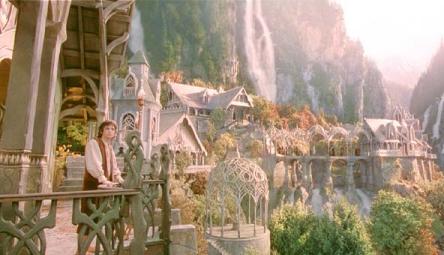 Home
of Elrond in Rivendell.
It is not known precisely when the Last Homely House was built, but Elrond
established his refuge in Rivendell in 1697 of the Second Age. In addition
to Elrond and his family, a number of other Elves resided or visited there.
Among these were the Elf-lord Glorfindel,
Elrond's counsellor
Erestor, and Lindir.
Aragorn
was raised in the Last Homely House from 2933 to 2951 of the Third Age,
and he frequently returned to visit. The Hobbit Bilbo
Baggins made his home there from 3002 to 3021. After Elrond left Rivendell
in 3021, his sons Elladan and Elrohir
and other High-Elven folk dwelled in the Last Homely House for some time.
Home
of Elrond in Rivendell.
It is not known precisely when the Last Homely House was built, but Elrond
established his refuge in Rivendell in 1697 of the Second Age. In addition
to Elrond and his family, a number of other Elves resided or visited there.
Among these were the Elf-lord Glorfindel,
Elrond's counsellor
Erestor, and Lindir.
Aragorn
was raised in the Last Homely House from 2933 to 2951 of the Third Age,
and he frequently returned to visit. The Hobbit Bilbo
Baggins made his home there from 3002 to 3021. After Elrond left Rivendell
in 3021, his sons Elladan and Elrohir
and other High-Elven folk dwelled in the Last Homely House for some time.
The Last Homely House was located in a deep, hidden valley. There was only one path leading to the house. It passed over a narrow stone bridge without a parapet that spanned one of the swift-running mountain streams that formed the River Bruinen.
The house was large and had many rooms and halls. Sam Gamgee commented, "It's a big house this, and very peculiar. Always a bit more to discover, and no knowing what you'll find round a corner." (FotR, p. 237-38) The main room was the Hall of Fire. It was so named because of the great hearth set between two carved pillars with a fire that blazed year-round. The Hall of Fire was usually a quiet place for people to sit and think, but on high days it was filled with stories and songs.
Across a corridor from the Hall of Fire was a dining hall with a long table. There was a dais at one end where Elrond sat, and in the middle of the table was a chair with a canopy used by his daughter Arwen. Woven cloths hung on the walls.
Other rooms included a number of bedchambers. Bilbo's room overlooked the gardens and faced south across the ravine of the Bruinen. The room that Frodo Baggins was given while he recuperated at Rivendell in the fall of 3018 had a flat ceiling with richly carved wooden beams. There was porch on the east side of the house that was used for the Council of Elrond on October 25, 3018. The Last Homely House was also a repository of books and lore on the history of the Elves and Middle-earth.
Bilbo described the Last Homely House as "a perfect house, whether you like food or sleep, or story-telling or singing, or just sitting and thinking best, or a pleasant mixture of them all." (FotR, p. 237)
Names &
Etymology:
Also called the Last Homely House
East of the Sea and the House of Elrond.
Sources:
The Hobbit:
"A Short Rest," passim
The Fellowship
of the Ring: "Prologue: Note on the Shire Records," p. 24-25; "Many
Meetings," 231, 237-39, 242, 250-51, and passim; "The Council of Elrond,"
p. 252 and passim; "The Ring Goes South," p. 290 and passim
The Return
of the King: "Many Partings," p. 264-67
Meduseld |
Meduseld
in the New Line film
|
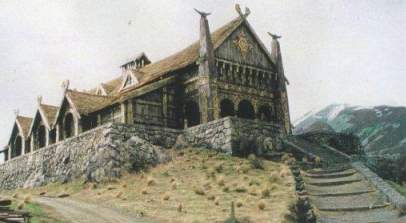 Hall
of the Kings of Rohan. Meduseld was in Edoras,
the main town of Rohan at the foot of the White
Mountains. Edoras was built on a hill and Meduseld was at the summit,
standing apart from the other buildings on a high platform built upon a
green terrace.
Hall
of the Kings of Rohan. Meduseld was in Edoras,
the main town of Rohan at the foot of the White
Mountains. Edoras was built on a hill and Meduseld was at the summit,
standing apart from the other buildings on a high platform built upon a
green terrace.
Meduseld was a great hall. Its thatched roof gleamed golden in the sunlight and could been seen from afar. A long, broad stair led up the green terrace to a wide paved area in front of the door. Guards sat on seats carved from stone on either side of the top step. The doors faced north and were made of wood carved with images of beasts and birds with jewelled eyes and golden claws. On either side of the doors stood pillars hewn from mighty trees carved with interlacing figures that were gilded and painted.
The interior of Meduseld was a single long room. The high roof was supported by pillars that were decorated with carvings and gold and other colors. There was a louver in the roof that let out smoke and let in light. Light also came into the hall through slitted, unglazed windows under the eaves on the eastern side.
On the walls were woven cloths that depicted scenes and figures from the history of the Rohirrim, including one of Eorl the Young mounted on Felarof riding to the Battle of the Field of Celebrant. There was a long hearth in the middle of the hall. At the south end of the hall facing the door was a dais with three steps. On the dais was the King's throne, which was a great gilded chair.
Meduseld was built by Brego, son of Eorl. It was completed in 2569 of the Third Age. At the feast held to hallow the hall, Brego's son Baldor vowed to walk the Paths of the Dead. He never returned, and his father Brego died of grief a year later.
In 2758, Edoras was seized by the Dunlendings led by Wulf. Haleth, son of King Helm, died defending the doors of Meduseld. Wulf called himself King and he sat on the throne in Meduseld. At the end of the Long Winter, Helm's nephew Frealaf led a company of Rohirrim from the refuge at Dunharrow and surprised Wulf in Meduseld. Frealaf slew Wulf and reclaimed the Golden Hall.
Gandalf the Grey came to Meduseld in September of 3018 and warned King Theoden that Saruman was preparing to make war against Rohan, but Theoden was under the influence of Saruman's lackey Grima Wormtongue and he sent Gandalf away.
Gandalf returned to Meduseld on March 2, 3019, with Aragorn, Legolas, and Gimli. They were greeted by Hama the Doorward and were asked to leave their weapons at the door of the hall. Aragorn was reluctant to leave Anduril, but at last he did so, though Gandalf kept his staff. Gandalf freed King Theoden from Grima's influence and the King decided to go to war against Saruman. He invited his guests to take refreshment with him in Meduseld before they set out.
King Theoden was killed at the Battle of the Pelennor Fields and after the war his body was brought back to Edoras for burial. The feast after Theoden's funeral on August 10 was the highest ever held in Meduseld. The hall was arrayed with fair hangings and filled with light. In attendance were the members of the Fellowship as well as Queen Arwen, Elrond and his sons, Galadriel, Celeborn, Faramir, Prince Imrahil, and others. They honored the memory of King Theoden and drank a toast to Eomer, the new King of the Golden Hall.
Names &
Etymology:
Also called the Golden Hall.
Meduseld
means "mead hall" from the Old English medu meaning "mead" - a honeyed
wine - and
sæld meaning "hall." A mead hall was the hall of
a chief in Anglo-Saxon times where banquets were held. Heorot, the mead
hall of Hrothgar in Beowulf, is an
example.
Sources:
The Two
Towers: "The King of the Golden Hall," passim
The Return
of the King: "Many Partings," p. 254-56
Appendix
A of The Lord of the Rings: "The House of Eorl," p. 347-49
The History
of Middle-earth, vol. VII, The Treason of Isengard: "The King of the
Golden Hall," p. 444 (description of the doors)
The Letters
of J.R.R. Tolkien: Letter #210
Beowulf
Glossary
Names &
Etymology:
Rhosgobel is said to mean
"russet walled town," "russet enclosure" in Sindarin. The word rhosc
means "brown." The word gobel means "walled town." Tolkien also
related the name Rhosgobel to "Brownhay," where brown refers to Radagast's
color and hay is a hedge or wall.
Sources:
The Hobbit:
"Queer Lodgings," p. 129
The Fellowship
of the Ring: "The Council of Elrond," p. 269; "The Ring Goes South,"
p. 287
Unfinished
Tales: "The Istari," note 4 and index entry
The History
of Middle-earth, vol. 5, The Lost Road and Other Writings: "The Etymologies,"
entries for PEL(ES) and RUSKA
The History
of Middle-earth, vol. 7, The Treason of Isengard: "The Ring Goes South,"
note 10; "The First Map of The Lord of the Rings," Map II
Smials |
Smials
in the New Line film
|
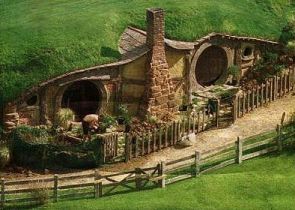 Hole
dwellings used by Hobbits. A smial was composed of a tunnel or tunnels
and rooms dug into the ground. Hills and banks were the most suitable locations
for smials.
Hole
dwellings used by Hobbits. A smial was composed of a tunnel or tunnels
and rooms dug into the ground. Hills and banks were the most suitable locations
for smials.
The tunnels of a smial were generally tube-shaped with round doors and round windows. The simplest smials had dirt walls and floors, while the better smials had panelled walls and tiled floors. Some smials were very small, while others had several branches and rooms. Brandy Hall and the Great Smials were mansions with numerous tunnels and rooms where many members of an extended family lived. Bag End was an example of a large, single-family smial that had many rooms on either side of one main tunnel.
Hobbits had lived in smials for as far back as they could remember. The people of Rohan remembered legends from when they lived in the North of the Halflings who lived in holes in sand dunes. After the Hobbits settled in the Shire, the custom of building smials remained, but Hobbits also began to build houses and other buildings above ground. By the end of the Third Age, it was generally the poorest and richest Hobbits who still dwelled in smials.
Names &
Etymology:
The word smial is derived
from the Old English smygel meaning "retreat, burrow." The actual
Hobbit word was trân. Also called Hobbit-holes.
Sources:
The Hobbit:
"An Unexpected Party," p. 9-11
The Fellowship
of the Ring: "Prologue - Concerning Hobbits," p. 15-16
The Two
Towers: "The Road to Isengard," p. 163
Appendix
F of The Lord of the Rings: "The Languages and Peoples of the Third
Age," p. 415
In the year 61, Sam brought the Red Book to his daughter before he left Middle-earth. The Red Book of Westmarch was a chronicle of the finding and destruction of the One Ring written by Bilbo Baggins, Frodo Baggins, and Sam Gamgee. With the Red Book were kept Bilbo's three-volume Translations from the Elvish, and at Undertowers a fifth volume of genealogies and other notes and commentary was compiled. These were preserved in the library of Undertowers for future generations along with other historical books and records.
Sources:
The Fellowship
of the Ring: "Note on the Shire Records," p. 23
Appendix
B of The Lord of the Rings: "The Tale of Years," p. 378
Appendix
C of The Lord of the Rings: Gamgee genealogy, p. 383
Vinyamar |
Map
of Vinyamar
|
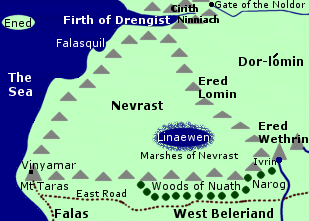 Halls
of Turgon in Nevrast. Vinyamar was located
on the west coast of Middle-earth overlooking the Sea. The hall was on
the slopes of Mount Taras which stood at the western end of a range of
hills extending from the Ered Wethrin. The temperate land of Nevrast lay
east of Vinyamar bounded by the mountains and the Sea.
Halls
of Turgon in Nevrast. Vinyamar was located
on the west coast of Middle-earth overlooking the Sea. The hall was on
the slopes of Mount Taras which stood at the western end of a range of
hills extending from the Ered Wethrin. The temperate land of Nevrast lay
east of Vinyamar bounded by the mountains and the Sea.
Vinyamar was a great hall with a shingled roof and windy courts high on the mountainside. The main door faced westward. The door was reached by a flight of wide steps and it was topped by a large lintel.
Inside, Turgon's main hall was lined with aisles of tall pillars. On a dais at the eastern end was the High Seat - a chair carved from a single stone engraved with symbols. There was a high window in a gable at the western end.
Terraces led down from Vinyamar to a clifftop protected by a seawall. A long stair descended the north side of Mount Taras to the seashore. A road went southward from Vinyamar to the Havens of Brithombar and Eglarest, and the East Road ran to the Ford of Brithiach and beyond.
Vinyamar was the first stone building made by the Noldor after their arrival in Middle-earth at the beginning of the First Age. It was established by Turgon, son of Fingolfin. From Vinyamar, Turgon ruled the realm of Nevrast including many Noldor as well as some Sindarin Elves who had dwelled in that land before the Noldor came.
But Turgon wanted to build a city like Tirion where he had lived in the Undying Lands. In the year 53, Turgon was guided to the hidden valley of Tumladen by Ulmo, the Vala of the Waters. Turgon began the construction of Gondolin which was completed in the year 116. At that time, he left Vinyamar and relocated with his people to Gondolin.
At Ulmo's bidding, Turgon hung a shield, hauberk, helm and sword on the wall behind his throne in Vinyamar before he departed. These tokens were intended for a messenger who would come to Gondolin from Nevrast to warn Turgon if danger approached.
The halls of Vinyamar stood empty for 379 years. It was untouched by Morgoth's servants and it remained undamaged albeit somewhat weather-worn and overgrown with plants.
In 495, a Man named Tuor was guided to Vinyamar by signs from Ulmo. Tuor found the arms that had been left by Turgon and put them on. He descended the north stairs to the seashore and Ulmo appeared before him and told him to seek Gondolin. A great storm came and Tuor took shelter for the night inside Vinyamar.
The next day he encountered an Elf of Gondolin named Voronwe who had been saved from a shipwreck by Ulmo and cast ashore at Vinyamar. Voronwe guided Tuor to Gondolin. Tuor married Turgon's daughter Idril and their son Earendil played a crucial role in bringing about Morgoth's defeat in the War of Wrath. Most of the land west of the Blue Mountains was destroyed in the war including Nevrast and Vinyamar.
Names &
Etymology:
The name Vinyamar means "New
Dwelling" in Quenya from vinya meaning "new" and már
meaning "home, dwelling."
Sources:
The Silmarillion:
"Of the Return of the Noldor," p. 115; "Of Beleriand and Its Realms," p.
119; "Of the Noldor in Beleriand," p. 125, 130; "Of Tuor and the Fall of
Gondolin," p. 238-40; Index entry for Vinyamar; "Appendix - Elements
in Quenya and Sindarin Names," entry for bar
Unfinished
Tales: "Of Tuor and His Coming to Gondolin," p. 26-33, 36, 41, 46,
51, 54 note 21
The History
of Middle-earth, vol. XI, The War of the Jewels: "The Grey Annals,"
p. 35, 44-45
Quenya-English
Wordlist
Wellinghall |
Wellinghall
by Ted Nasmith
|
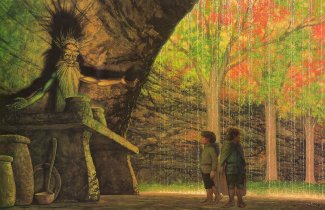 Home
of
Treebeard in Fangorn
Forest. Wellinghall was located deep in the forest at the foot of Methedras,
the last peak of the Misty Mountains. It was one of several Ent-houses
where Treebeard dwelled.
Home
of
Treebeard in Fangorn
Forest. Wellinghall was located deep in the forest at the foot of Methedras,
the last peak of the Misty Mountains. It was one of several Ent-houses
where Treebeard dwelled.
Two evergreen trees with intertwined branches stood at the entrance to Wellinghall. Beyond, a wide roofless hall stretched back into the mountainside. The walls on either side sloped upward to a height of 50 feet and they were topped with rows of trees. In the wall of rock at the far end was a shallow cave with an arched roof. A stream from above formed a waterfall across the cave entrance and collected in a stone basin before flowing on to join the Entwash.
Inside the cave there was a six-foot-high stone table but no chairs, because Ents did not sit. There was also a low bed covered with grass and ferns. Treebeard used the bed to lie down on, but he slept standing up - sometimes under the waterfall. Light was provided by two great vessels filled with glowing liquid, one golden and one green. Jars of Ent-draughts were also stored at the back of the cave.
Treebeard brought the Hobbits Merry Brandybuck and Pippin Took to Wellinghall on February 29, 3019 of the Third Age, and they spent the night there before proceeding to Derndingle for the Entmoot the next day.
Names &
Etymology:
Wellinghall means "hall under
the welling (or outflow) of the spring."
Sources:
The Two
Towers: "Treebeard," p. 69, 72-74, 77, 81-82; "Flotsam and Jetsam,"
p. 169
"Nomenclature
of The Lord of the Rings," entry for Wellinghall
All entries are Copyright © by the Thain from former tuckborough.net. Please contact me if you are Thain or know anything about how to contact the original author.
2003-2011, The Thain's Book - thainsbook.minastirith.cz
- e-mail: thain at tuckborough.net